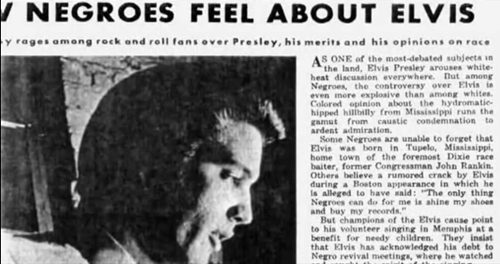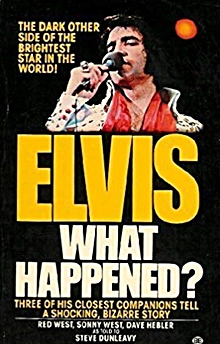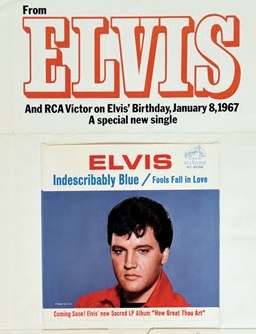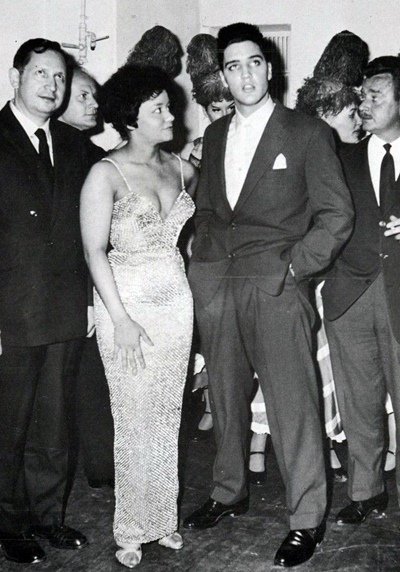 |
 |

Thirty Pieces of Silver: The Betrayal of Elvis Presley, Joyce Rochelle Vaughn, Justice Payne Publishing, USA, 2016, Hardcover (with d/j), 713 pages, Illustrated, ISBN-13: 978-0998270814
The ReviewTruth is not always easily detected. However, lies become transparent and easy to see because they always contradict themselves. Contextual information: Ms Vaughn starts the Preface to her book with the following statement:
She also asks the question: “Why would an African American woman defend a white man she was raised to hate?” (Ms Vaughn also succinctly and powerfully provides the answer)
Hands up those of you familiar with Joyce Rochelle Vaughn’s book, Thirty Pieces of Silver: The Betrayal of Elvis Presley? I suspect not too many are raising their hand. While this book has received brief mention on a number of online Elvis discussion groups and in at least one Elvis book, it appears to have generally slipped well under the radar in the Elvis world. The author summarises her work, which is the result of 40 years of research, by stating that it is ‘a full study and complete unmasking of falsely reported news surrounding the life and twenty-one year career of Elvis Presley. In this publication, not only are the racial deceptions debunked, but an investigation into the allegations coming from Elvis: What Happened? [Red West, Sonny West and Dave Hebler as told to Steve Dunleavy] are looked at and quashed. The author also focuses on the many contradictions from Elvis: Still Taking Care of Business, which was published thirty years later by Sonny West.'
The Narrative:
The text and author’s argument is presented in chronological order. In many respects the book also provides a detailed (but necessarily selective) biographical account of Elvis’ life and career. The author’s passionate disdain for the disciples who betrayed Elvis is clear throughout the book's impressive 713 pages.
I cannot detail all of the issues Ms Vaughn addresses, as not surprisingly over more than 700 pages there are far too many to list or discuss. The following are representative of the eclectic range of things you will find discussed and argued in Thirty Pieces of Silver:
About the infamous article in Sepia magazine (April 1957) – see 'Contextual Information' (above) for the quote which ignited the false, but enduring, rumor, that Elvis was racist:
Ms Vaughn provides a detailed account of the Sepia article, investigation of it (the ongoing changing of the story by Sepia editors under scrutiny and presentation of the facts is galling), and its “debunking” in another Black American magazine, Jet.
About “The Battle of Grenada” (physical altercation post show in a diner as told by Red West):
Elvis’ lack of marital relations with Priscilla post Lisa Marie’ birth:
Ms Vaughn includes a one page discussion of the effects of giving birth and how for up to six weeks post birth, doctors will usually recommend there be no sexual activity. EIN's understanding of the ‘absence of post birth physical relations’ between Elvis and Priscilla is that it was an ongoing issue, not a temporal one (with one notable exception).
Elvis' Black audience: In reading Thirty Pieces of Silver I appreciated the author’s important discussion about how the American mainstream media purposely ignored Elvis’ Black audience. There are in fact numerous photos of African Americans at Elvis concerts and of Elvis with his Black fans. While Elvis was happy bringing Black and White Americans together, mainstream media was happy to reinforce a segregated view. Some of the many other issues addressed in Thirty Pieces of Silver are:
I expect that some readers will feel the author makes more out of some issues than is warranted. For example, contradictions in accounts (over time) around the circumstances of certain incidents may simply be due to the vagaries of one’s memory as they get older. It could also be that with later consideration of an issue previously forgotten information is retrieved, or becomes apparent when discussing it with others who also experienced the incident(s). Certain issues, such as members of the Memphis Mafia blaming Elvis for them cheating on their wives or partners, are a subjective matter in that while individuals need to take personal responsibility, their perception and/or perceived influence of another, can color their judgment. Accordingly, while their claim can be seen to be, or may be wrong, it does not mean they were deliberately lieing. An incident at Graceland in February 1967 also illustrates the point:
The author takes a different viewpoint on the incident, though I couldn’t help feeling she was automatically driven to take exception to what was being claimed:
Ms Vaughn's use of “may” and “maybe” reflects conjecture on her part and Elvis being concerned about costs/money is not consistent with what other accounts, and his known profligate spending patterns, tell us about Elvis and money.
At another point, the author takes exception to Red West claiming it took Elvis two months (when in fact it was only two days) before Elvis dubbed his voice into the songs Indescribably Blue, I’ll Remember You, and If Every Day Was Like Christmas. Is this a major issue? To Ms Vaughn it (and other claims) are symptomatic of her theme that the Wests, et al:
The author’s value laded approach to the antagonists at the centre of her book is further reflected in these passages (page 312) about Sonny West:
A reservation I have about Thirty Pieces of Silver is that, at times, the author goes off on tangents not directly related to the underlying issue. For instance, one section in the book is: The Punishment for Loving Someone. An Argument for Alimony Reform.
Another example is with the book's 12 appendices, which, while an intriguing collection, comprise titles such as:
The book also includes a Preface, two Introductions, 21 chapters, 12 Appendices, an 11 page Bibliography, a five page glossary, Description of Large Photographs, and a substantial 22 page Index. The author provides page footnotes (source, page numbers, etc) for each of the issues discussed. The Visuals: Thirty Pieces of Silver features hundreds of photos, all presented nicely on the page (and many are full page images). Most of the photos are in b&w, many are familiar, and some are striking, for example on pages 456-57 we are treated to a great double page spread of Elvis ‘live” in Vegas, down on one knee, microphone to his mouth, his hairy chest exposed with his white jumpsuit open to just below his chest.
Other impressive images include:
While the text tends to dominate the book, when you least expect it a great visual appears offering good balance between text and image. The book also features various press clippings, other interesting archival material, and song recordings and concert lists.
The Book Design: Thirty Pieces of Silver is a deluxe hardcover (with dust jacket) coffee table release (measuring 12" x 9" x 2"). It is also weighty, tipping the scales at over 7 pounds/3+ kgs and as already noted comprises 713 pages complemented by many color and b&w visuals. The paper stock is quality semi-gloss/gloss and the line spacing a visually comfortable 1.5. While some readers may feel there is too much use of white (and sometimes blue) space per page, given the weight of the book and the sheer volume of information it contains, I can understand the author’s decision (as it ensures ease of reading). The number of pages and weight of the book also necessitated larger than normal page borders at the book spine. HOWEVER, a major issue with the book is that due to its size, weight and number of pages, the perfect binding is insufficient to securely hold the pages. I found that after only a few openings, pages (particularly at the back), started to come loose. This needs to be addressed.
The Price: Thirty Pieces of Silver is not only a large, voluminous book, it also carries a hefty price tag (particularly if you live outside the US). It is independently published by the author (through her company, Justice Payne Publishing) and costs US$87.98. Postage plus tax appears to be between $11 and $16 (within the continental USA). International shipping is considerably higher. For example, USPS Priority Mail International Flat Rate postage to Australia is US$77.80 (almost doubling the cost of the purchase – circa 9 August 2019 the book plus shipping cost to Australia was around A$240).
Ms Vaughn’s sophisticated website allows you to calculate the postage cost at checkout. Value added information: In addition to the book, purchasers receive a key code allowing access to a supplemental website at no extra charge. This supporting website provides a range of additional information, live interviews, fake and mislabelled photographs, performances, and more. Verdict: Thirty Pieces of Silver: The Betrayal of Elvis Presley conflicted me. On the one hand I appreciated the research and stimulating reading Ms Vaughn's book offers. On the other hand I was concerned about her antagonism towards those she considers to have betrayed Elvis, which at times I felt was too overtly stated and clouded her objectivity. Having said this, Thirty Pieces of Silver is an impressive and comprehensive examination of important issues and claims made about Elvis. I don’t agree with all of Ms Vaughn’s views/conclusions, and at times she engages in conjecture - how would one know whether her view or the view of one of the Memphis Mafia is the correct one? As with many contentious things in life, perhaps the truth lie somewhere in the middle? However, Ms Vaughn has the right to state her views and undoubtedly she has written a powerful, engrossing and likely a contentious account of controversies, claims and misreporting about Elvis and his life and career. In my opinion, it is on issues like Elvis and racism that the author is strongest in her argument. The book is likely to divide fans and if it does, this is a good indicator of its value in the Elvis literary canon.......challenging people’s perceptions and the myths that continue to plague the Elvis story makes us think and reconsider our position (putting our brains into critical mode is invariably a good thing). There is certainly plenty to think about in Thirty Pieces of Silver: The Betrayal of Elvis Presley. I also challenge the reader to find another book (apart from a dictionary) that contains the word “floccinaucinihilipilification”!
|
|






